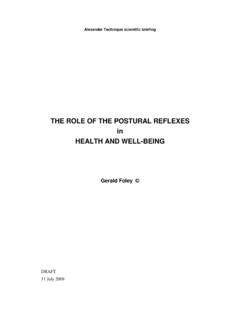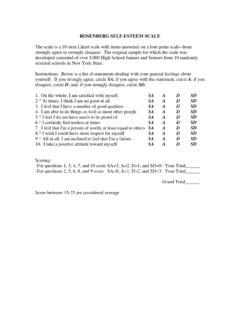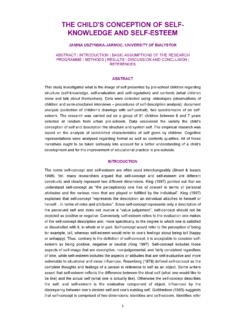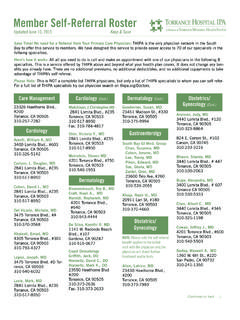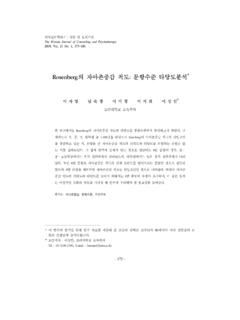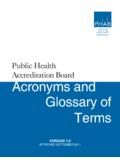Transcription of The Alexander Technique
1 34 Somatics 2008 Surely, I argued, if it is possible for feeling to become untrustworthy as a means of direction, it should also be possible to make it trustworthy again (F. M. Alexander , 1984/1932, p. 1).After having observed the poor state of his own functioning, including prob-lems involving the voice, breathing, posture, balance, and body expression, F. M. Alexander (1869-1955) investi-gated and observed that he himself was causing these problems through mus-cular interference misusing himself. These undue tensions, being habitual, were not immediately evident sensori-ally, in spite of their constant damaging effect. Eventually, his research led him to discover a guidance and control system that organizes the body for op-timum functioning and coordinates the distribution of psychophysical processes by starting with the head and spinal column the primary control. In nature this mechanism is automati-cally activated in response to a stimu-lus, preparing the organism for action or human being, like other verte-brate animals, relies instinctively and unconsciously upon kinesthesia to co-ordinate the guidance and control sys-tems, affecting such vital aspects as bal-leading to his own generalized misuse, he reasoned that improvement of his use and functioning was dependent upon the recovery of reliable kinesthet-ic guidance and control.
2 Additionally, he found that this was an impossible task without the recuperation of the primary control mechanism, which he was able to achieve through a long, conscious, and rational process. The Alexander Technique involves a teacher activating the student s primary control mechanism so that she does not have to rely upon her unreliable kinesthesia to guide her, the result of which is a recovery of natural and ef-ficient use and functioning. (I have made the arbitrary decision to always refer to the teacher in the mascu-line and the student in the feminine throughout this paper.) By directing herself consciously and becoming sen-sorially aware of the new conditions, the student rescues what was originally unconscious sensory guidance. She gradually becomes able to activate her own primary control, focusing on and analyzing the resultant sensory information, in effect creating a sense register that will guide and assure that the effort needed for any activity is just and efficient.
3 Ance, locomotion, partial movements, voice, breathing, and other physiologi-cal functions like blood circulation and digestion. When the natural conditions are neither defective nor impeded, kinesthesia is the mind-body commu-nication link that helps to assure the most natural and efficient conditions of use and functioning. However, as inefficiency becomes the standard, kinesthesia becomes an unreliable co-ordinator, reporting to the brain that the new (incorrect) conditions are the correct ones, leading to a vicious cycle of misuse and the development of civiliza-tion, humans have created an un-natural environment and adapted themselves to a sedentary lifestyle with highly developed mental processes, both disintegrators of the natural psy-chophysical unity, which have brought with them a gradual lowering of the standards of use and functioning. Alex-ander presented a hypothesis that in-volves self-direction and guided sensory education, objectives of which are the establishment of a reliable sense regis-ter and the conscious activation of the primary control mechanism as the ba-sis for organically structured use of the self.
4 As he understood the conditions TheBy Bobby Rosenberg, Certified Teacher of the Alexander TechniqueAlexander Technique and Somatic EducationVolume XV Number 4 35 The Field of Somatics F. Matthias Alexander , father of the Alexander Technique , was the first per-son to take somatic education out of the realm of shamanistic mystery and establish it as a verifiable, pragmatic Technique (Thomas Hanna, 1990-91, p. 4).Since the times of F. M. Alexander , at the end of the nineteenth century, we have seen a steady growth of prac-tices that invite the individual to par-ticipate in the processes involved in the improvement of her body conditions in the integrated, psychophysical sense. Some of these practices developed into therapeutic methods and others into reeducation systems; still others, like Taiji Quan, yoga, and Zen, were imported from Asia and tailored to the contextual interests and needs of the late 1960s, when the term somatics took on a special the traditional sense, The term somatic refers to the body, as distinct from some other entity, such as the mind.
5 The word comes from the Greek word (Somatik s), meaning of the body. It has different meanings in various disciplines (Wikipedia). To place the term in its contemporary context, I have cited the definitions of somatics and somatic education from the published works of Thomas Hanna: Somatics is the field which stud-ies the soma: namely, the body as perceived from within by first-person perception. When a human being is observed from the outside , from a third-person viewpoint the phenom-enon of the human body is perceived. But, when this same human being is observed from the first-person view-point of his own proprioceptive senses, a categorically different phenomenon is perceived: the human soma. The two distinct viewpoints for ob-serving a human being are built into the very nature of human observation, which is equally capable of being in-ternally self-aware as well as externally aware. The soma, being internally per-ceived, is categorically distinct from a body, not because the subject is differ-ent, but because the mode of viewpoint is different: it is immediate propriocep-tion a sensory mode that provides unique data.
6 Reciprocity between sensing and moving is at the heart of the somatic process.. The human is not merely a self-aware soma, passively observing itself (as well as observing its scientific observer), but it is doing something motor s goal is to overcome SMA by becoming sensorially aware of the functions that have been lost via sen-sory-motor education. He gives credit to many of his forerunners, particularly to Alexander and Feldenkrais. To the first, he attributes means whereby, or teacher guidance to help the student become sensorially aware of uncon-scious involuntary movement patterns while demonstrating the desired mus-cular response. However, even though Hanna, like Feldenkrais, accepts the need for a special focus on the use of the head, neither seems to have placed much importance on what I consider to be the outstanding contribution of Alexander the primary control education is clearly intend-ed as an antidote to the harmful effects of the inefficient use of the human being in modern times.
7 In the 1960s Thomas Hanna, together with many others who had experienced and were exploring the implications of their body epiphany (Maupin, 1998), be-gan to use the term somatics to refer to the first-person experience of the body, as distinct from the third-person perspective used in medicine and ther-apy. The Alexander Technique , having been developed prior to the concept of somatics, nonetheless is founded upon the realization that the modern-day hu-man being s sense register has become unreliable, leading to misuse and mal-functioning of the self. One of Alexan-der s principal concerns is the recovery of this sense register obviously just an earlier way of expressing what the post- Alexander somatics practitioners call somatic education. The Role of Sensory Education in the Alexander Technique The mind has not been taught to reg-ister correctly the tension or, in other words, to gauge accurately the amount of muscular effort required to per-form certain acts, the expenditure of effort always being in excess of what is required (F.)
8 M. Alexander , 1910, p. 83). A study of Alexander s major pub-lications reveals a gradual evolution of what he considers to be his Technique . I have focused on his definition of what comprises a lesson, together with a brief theoretical framework with em-phasis on his particular methodology for guiding the student in her acquisi-tion of a new sensory simultaneously: it is acting upon it-self: , it is always engaged in the pro-cess of self-regulation (Hanna, 1986).And, Somatic education is the use of sensory-motor learning to gain greater voluntary control of one s physiological process. It is somatic in the sense that the learning occurs within the individu-al as an internalized process. In its purity, somatic education is self-initiated and self-controlled. How-ever, somatic education has emerged during the twentieth century as a pro-cedure whereby this internalized learn-ing process is initiated by a teacher who stimulates and guides the learner through a sensory-motor process of physiological change (Hanna, 1990-91, p.
9 4).As far as I can tell, Alexander never used the word somatics, but his fre-quent references to kinesthesia, sen-sory awareness, and feeling place him squarely in the center of the field of somatics. In this article, my particu-lar interest is in Alexander s insistence upon the teacher guiding the student in the recovery of a reliable kinesthetic sense, whereby she can begin to rescue the natural and efficient use of Somatic EducationConsidered by many to be the father of the somatics movement, Thomas Hanna created the Somatic Education system based on the observation that as many as fifty percent of the cases of chronic pain suffered by human beings are caused by sensory-motor amnesia (SMA) a condition in which the sen-sory-motor neurons of the voluntary cortex have lost some portion of their ability to control all or some of the muscles of the body (Hanna, 1990-91, p. 7). He suggests that instead of thera-peutic treatment, a reeducation of the voluntary sensory-motor cortex is the most viable means for overcoming this movement and postural habits are developed, the body-mind becomes conditioned to repeat the muscular patterns involved until they become unconscious.
10 The habitual feeling, if indeed it is felt at all, fades into the background and is registered as nor-mal ; one gradually becomes unable to intervene in the means whereby the movement is achieved, and the unconscious use is repeated. If, as most somatic educators agree, these patterns of use are defective, all activity becomes harmful; hence, the need for sensory-36 Somatics 2008 Control of the Individual (1923/1985), to be a much clearer representation of his work than MSI. He dedicates a great deal of this book to the develop-ment of his theory regarding sensory appreciation. For an in-depth look at Alexander s thinking, see Consider-ation of Three Stages of Man s Devel-opment in relation to Deterioration of Sensory Appreciation (1923/1985, pp. 39-53). This pseudo-anthropological discourse gives us an interesting insight to Alexander s view of the far-reaching influence of his work, and it presents a believable explanation for the state of man s misuse and malfunctioning in modern times.
